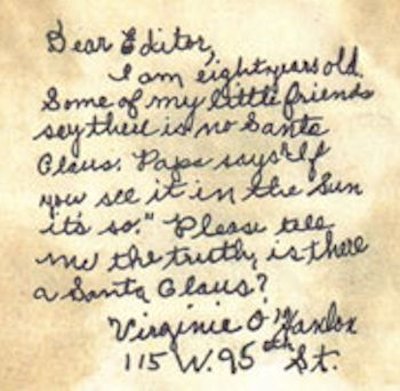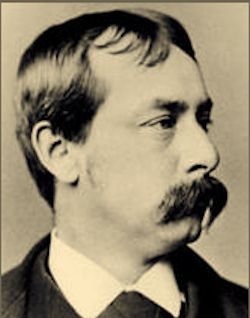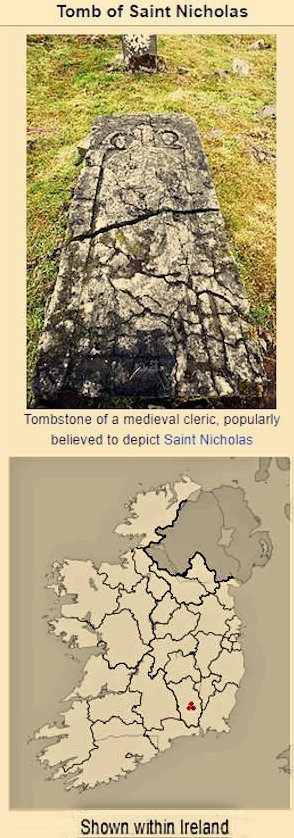|
|
|
|
Eight-year-old Virginia O’Hanlon wrote a letter to the editor of New York’s Sun, and the quick response was printed as an unsigned editorial Sept. 21, 1897. The work of veteran newsman Francis Pharcellus Church has since become history’s most reprinted newspaper editorial, appearing in part or whole in dozens of languages in books, movies, and other editorials, and on posters and stamps |
|
|
DEAR EDITOR: I am 8 years
old. VIRGINIA, your little friends are wrong. They have been affected by the skepticism of a skeptical age. They do not believe except they see. They think that nothing can be which is not comprehensible by their little minds. All minds, Virginia, whether they be men’s or children’s, are little. In this great universe of ours man is a mere insect, an ant, in his intellect, as compared with the boundless world about him, as measured by the intelligence capable of grasping the whole of truth and knowledge. Yes, VIRGINIA, there is a Santa Claus. He exists as certainly as love and generosity and devotion exist, and you know that they abound and give to your life its highest beauty and joy. Alas! how dreary would be the world if there were no Santa Claus. It would be as dreary as if there were no VIRGINIAS. There would be no childlike faith then, no poetry, no romance to make tolerable this existence. We should have no enjoyment, except in sense and sight. The eternal light with which childhood fills the world would be extinguished. Not believe in Santa Claus! You might as well not believe in fairies! You might get your papa to hire men to watch in all the chimneys on Christmas Eve to catch Santa Claus, but even if they did not see Santa Claus coming down, what would that prove? Nobody sees Santa Claus, but that is no sign that there is no Santa Claus. The most real things in the world are those that
|
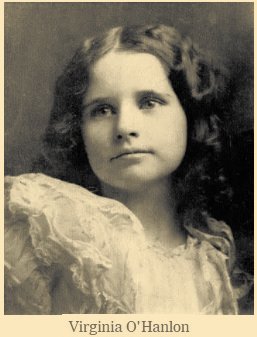 neither children nor men can see. Did you ever see fairies dancing on the lawn? Of course not, but that’s no proof that they are not there. Nobody can conceive or imagine all the wonders there are unseen and unseeable in the world. You may tear apart the baby’s rattle and see what makes the noise inside, but there is a veil covering the unseen world which not the strongest man, nor even the united strength of all the strongest men that ever lived, could tear apart. Only faith, fancy, poetry, love, romance, can push aside that curtain and view and picture the supernal beauty and glory beyond. Is it all real? Ah, VIRGINIA, in all this world there is nothing else real and abiding. No Santa Claus! Thank God! he lives, and he lives forever. A thousand years from now, Virginia, nay, ten times ten thousand years from now, he will continue to make glad the heart of childhood.
Francis Pharcellus Church |
*****************************************************************************************
Bio: Santa Claus (aka St. Nicholas, Sinter Klaas)
Submitted by Father Time
Surnames: Chris, Claus, Clement, Irving, Sundblom
----Source: https://www.coca-colacompany.com/au/news/definitive-history-of-santa-claus
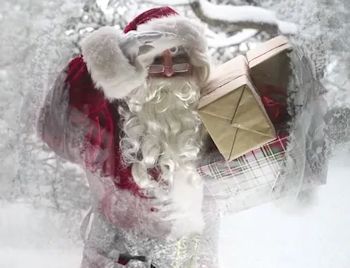
The Definitive History of Santa Claus
For the second time in your life, you’re going to need to forget everything you think you know about Santa Claus.
While the first big revelation all those years ago may have been fraught with disappointment, the true history of how the big, jolly man in the red suit came to be is completely fascinating and filled with the quirky enchantment we’ve come to expect from Christmas.
In the story we’re about to tell you, the legend of Santa spans multiple continents, assumes many different identities, gets hijacked by first settlers in colonial America, takes a trip through the Civil War, and gets a makeover from a New York advertising firm - thanks to the best known soft drink in the world.
Let’s start at the beginning
If you were to ask people where the legend of Santa Claus began, they’d probably start by telling you that the name “Santa” is merely a moniker for Saint Nicholas, a man who existed a long time ago and was renowned for his generosity toward children.
We hear about Saint Nick in carols like Rudolph the Red Nosed Reindeer, and stories like The Night Before Christmas, but beyond that the man remains a bit of a mystery.
By all accounts, his story begins in the fourth century AD in what is now modern-day Turkey. A man named Nicholas became the bishop of a village called Myra. He was later canonized, and soon became one of the most popular saints in Christianity.
Saint Nicholas
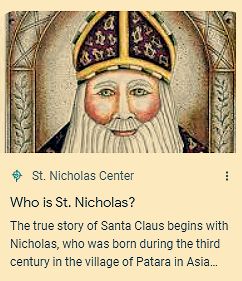
That’s about all we know for sure but much of the folklore surrounding Saint
Nick speaks of his kindness and generosity toward children, in a world where
those attitudes weren’t easy to find.
Despite being the patron saint of many European countries including Russia,
Austria, Belgium, France and Germany, it was in the Netherlands where we
first began to see some semblance of the Santa Claus we’re familiar with
today.
Each year, the much-loved saint was honored during the Feast of Saint
Nicholas (or Sint-Nikolaas), where parents would leave gifts out for their
children, who naturally believed Saint Nicholas had paid them a visit during
the night.
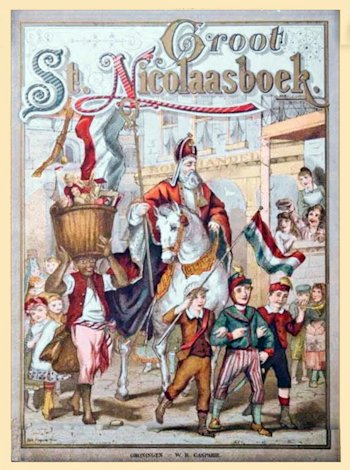
Unlike the modern depictions of Santa, the Dutch version of Saint Nick rode
on a donkey and wore a tall pointy bishop’s hat.
In the same way kids today leave out a glass of milk with some cookies for
Santa and his reindeer, Dutch children would fill their clogs with straw and
leave them out for the donkey to eat.
When they woke the next morning, they’d find the straw gone and their shoes
packed with presents.
Santa’s move to America
Like most myths, the story of Saint Nicholas evolved and became embellished
over the years and - given their fondness for him - it’s hardly surprising
to learn that in 1664, the legend of Saint Nicholas travelled across the
Atlantic to Dutch colony of New Amsterdam; or as it’s known today, New York
City.
In the 200 years that followed, and as a means of preserving their culture
and traditions in the face of British settlement, a group of Dutch
intellectuals gathered together and called themselves the "Knickerbockers."
A prominent member of the group was a writer named Washington Irving, who
published a book called The Knickerbocker's History of New York, containing
satirical versions of Dutch traditions and stories.
Throughout the book there were several dozen references to a "Sinter Klaas"
- an adaptation of "Sint Nikolaas" - accompanied by details of him flying
across the sky in a wagon and dropped presents down chimneys for good little
girls and boys.
Washington's wild, endearing description of the saint very quickly became
known to New Yorkers. The English settlers enthusiastically adopted the
joyful Dutch celebrations of St. Nicholas' Day, and gradually began to
combine them with their own traditions of celebrating Christmas and the new
year.
When it comes to pronunciation, it’s easy to see how “Sinter Klaas” could
translate to “Santa Claus” when you apply the accent of an English-speaking
New Yorker.
Clement Clarke Moore and the Night Before Christmas
Clement Clarke Moore was a friend of Washington Irving, and another
important contributor to the picture of Santa we have today.
Teresa Chris, author of the book The Story of Santa Claus, wrote that in
1822, Moore sat down to write his children a Christmas poem, having been
inspired by Irving's tales.
Clement’s poem, originally titled A Visit from St. Nicholas, soon became
known as the classic The Night Before Christmas and was so popular that
within a decade it had become canon with regard to the Santa legend.
When writing the poem, Teresa said Clement made a few alterations to the
Sinter Klaas legend to make the story more relatable to people from a
British/Anglo background, and it’s interesting to note how his alterations
still manifest in the Santa mythology of today.
"The clogs the Dutch children left by the chimney corner on December 6
became something all children could relate to in cold weather - stockings,
and the wagon became a "miniature sleigh" pulled by "eight tiny reindeer,"
Teresa wrote in her book.
The horse drawn sleigh with its bells was a common means of transport for
the English, and substituting horses with reindeer added an element of
mystery to Saint Nick, as though he was from an ice-capped Northern land,
where few people had traveled, somewhere secluded from the world.
It’s believed that Clement never intended for anyone other than his family
to hear A Visit From St. Nicholas. He allegedly even refused to admit he was
the author. Despite his objections, the poem wound up printed anonymously in
the New York Sentinel on December 23, 1823. Some say it was thanks to
Clement’s wife Catharine Taylor who liked the story so much that she sent
copies to her friends.
The mythology connecting Santa with the Christmas period had been well and
truly established by this stage, but there was still some discrepancy around
what exactly Santa looked like.
Thomas Nast and the American Civil War
In the mid-1800s, it was popular to draw Santa Claus either in his bishop's
robes or as a man with a pointed hat, long coat, and straight beard. It
wasn’t uncommon to see Santa drawn as quite tall and gaunt.
This changed in 1863, when Harper's Weekly hired a 21-year-old named Thomas
Nast to draw a picture of Santa Claus bringing gifts to troops fighting in
the American Civil War.
The Santa that Thomas drew combined Clement's description of Saint Nicholas
from The Night Before Christmas with the all too familiar propaganda image
of Uncle Sam.
Nast's Santa was a jolly, roly-poly old man who wore a star-spangled jacket,
striped pants, and a cap.
"The drawing boosted the spirits of soldiers and civilians alike because it
showed that the spirit of Christmas had come to the Civil War," wrote
historian James I. Robertson.
It was so popular, that every year, for 40 years, when the magazine asked
Nast to draw Santas, he stuck with the same concept - although he did
eventually drop the stars and stripes in favor of a plain wool suit.
Although this woolen suit was sometime green, Nast popularized Saint Nick’s
famous red clothes, more than four decades prior to The Coca-Cola Company’s
depiction of Santa - contrary to the rumour that “Coca-Cola made Santa red”.
The History of Coca-Cola and Santa Claus
If the American Santa Claus took shape by repetition, then it’s fair to say
that Coca-Cola led the charge through much of the 20th century - although it
would be unfair to say Coca-Cola invented Santa.
The company’s relationship with Santa began in the 1920s, when Coca-Colafirst
began advertising in American magazines like The Saturday Evening Postduring
the festive season.
The ads used images of a man dressed as Santa, not dissimilar in appearance
to the Santa Claus in Thomas Nast’s depiction from the mid-1800s. This Santa
was usually depicted outside the world’s largest soda fountain or visiting
high profile department stores, and things stayed that way up until the
1930s.
Christmas advertising had become a powerful part of Coca-Cola’s business
operations. In 1931 the company commissioned the services of D’Arcy
Advertising Agency and Michigan-born artist Haddon Sundblom to create a
campaign featuring a more wholesome and approachable Santa Claus - something
that captured the true essence of Santa himself, and wasn’t just a man
dressed up in a costume.
For his inspiration, Haddon turned to Clement’s The Night Before Christmas.
The description of Santa as a “jolly old elf” dressed in red furs who goes
down chimneys to give children their gifts was instrumental in laying the
foundations for our image of modern Santa Claus.
The poem described Santa as a dwarfish "jolly old elf," dressed in red furs
who goes down chimneys to give children their gifts. Clement's account was
so vivid and compelling that it became the standard.
In the early days Haddon called upon his friend, retired salesman Lou
Prentiss, to act as a live model on which he based his images. When Lou
passed away Sundblom used himself as a model and painted while looking into
a mirror.
From 1931 to 1964, Coca-Cola advertising showed Santa delivering toys (and
playing with them!), pausing to read a letter and enjoy a Coke, visiting
with the children who stayed up to greet him and raiding the refrigerators
at a number of homes.
Haddon’s Santa appeared regularly in The Saturday Evening Post as well as in
Ladies Home Journal, National Geographic, The New Yorker and more.
People paid such close attention to the Coca-Cola Santa images that when
anything changed they sent letters to The Coca-Cola Company. One year,
Santa's large belt was backwards (perhaps because Haddon was painting via a
mirror). Another year Santa Claus appeared without a wedding ring causing
fans to write asking what happened to Mrs Claus.
Haddon created his final version of Santa Claus in 1964 but for several
decades to follow Coca-Cola advertising featured images of Santa based on
Haddon’s original works.
Santa today
There has been little change to the popular representation of Santa Claus
since the 1960s. Sure, he may wear board shorts on Aussie Christmas cards
but he still rocks a beard. On the side of the Coca-Cola Christmas trucks in
Australia he’s still glowing with his shiny cheeks and twinkly eyes.
These days Santa can be emailed directly and tracked online as he flies
through the sky. It’s likely he and Mrs Claus run the world’s best supply
chain and his elves have Hollywood status.
But we’ll still leave the reindeers a carrot on Christmas eve (Australia),
put our shoes out (the Netherlands) or leave him rice porridge with cinnamon
sugar (Denmark). Great stories will always have a life of their own.
*****************************************************************************************
Obit: Claus, Santa (aka Staint "Nick" Nicholas)
*This death and burial is only alleged and cannot be substantiated with facts. The belief that the spirit
of Santa Claus will never die lives on in the heart of many true believers.
Surnames: Claus
....Source: Wikepedia
|
|
The tomb of Saint
Nicholas is a slab effigy in low relief of an early
4th-century ecclesiastic popularly associated with Saint Nicholas of
Myra in County Kilkenny, Ireland While more probably a local priest
from Jerpoint Abbey, it lies in the medieval lost town of Newtown
Jerpoint, just west of the Cistercian Jerpoint Abbey. It is 2.0 miles (3.2 km) southwest of Thomastown in the grounds of the privately owned Jerpoint Park. St. Nicholas's Church and graveyard are in the town, where the earthly remains of St. Nicholas of Myra are said to be buried. Belmore House stands at the top of the town. The memorial has been moved since 1839, and has sustained damage from the fall of a tree A conservation plan was developed by the Heritage Council in 2007. In advance of conservation work in 2013, St. Nicholas' church and the tomb were surveyed and modeled in 3D. The bones of St. Nicholas, who inspired the legend of Santa Claus, were believed to have been buried in Newtown Jerpoint in the 12th century. The grave's stone slab is carved with the image of a cleric with the heads of two knights behind each shoulder, said to be those of the two crusaders who, so the story goes, brought Nicholas's remains to Ireland. Evidence lends some credence to this tale as the Normans in Kilkenny were keen collectors of religious relics, and it is known that Norman knights participated in the Holy Land Crusades. |
|
© Every submission is protected by the Digital Millennium Copyright Act of 1998.
Show your appreciation of this freely provided information by not copying it to any other site without our permission.
Become a Clark County History Buff
|
|
A site created and
maintained by the Clark County History Buffs
Webmasters: Leon Konieczny, Tanya Paschke, Janet & Stan Schwarze, James W. Sternitzky,
|

